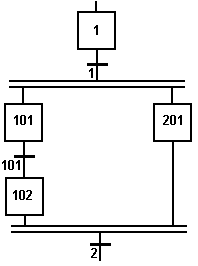Create SFC Parallel Branches
![]() "Sequential Function Chart"
It can be used to program processes that can be split into steps.
The main components of SFC are:
- Steps with associated actions
- Transitions with associated logic conditions
- Directed links between steps and transitions charts to represent parallel operations.
"Sequential Function Chart"
It can be used to program processes that can be split into steps.
The main components of SFC are:
- Steps with associated actions
- Transitions with associated logic conditions
- Directed links between steps and transitions charts to represent parallel operations.
- Parallel branches:
- Occur when more than several steps are connected after the same transition.
- Are drawn as double horizontal lines.
Figure 6-65: Parallel Branches
Using this example:
- When the transition before the divergence (1) is crossed, all steps beginning the parallel branches (101 and 201) are activated.
- Sequencing of parallel branches can take different timing according to each branch execution.
- The transition after the convergence (2) is crossed when all the steps connected before the convergence line (last step of each branch) are active.
- The transition indicates a synchronization of all parallel branches.
- If needed, a branch can be finished with an empty step (with no action).
- It represents the state where the branch waits for the other ones to be completed.
Remember these rules when drawing parallel lines to avoid dead locks in the execution of the program:
- All branches must be connected to the divergence and the convergence.
- An element of a branch must not be connected to an element outside the divergence.







